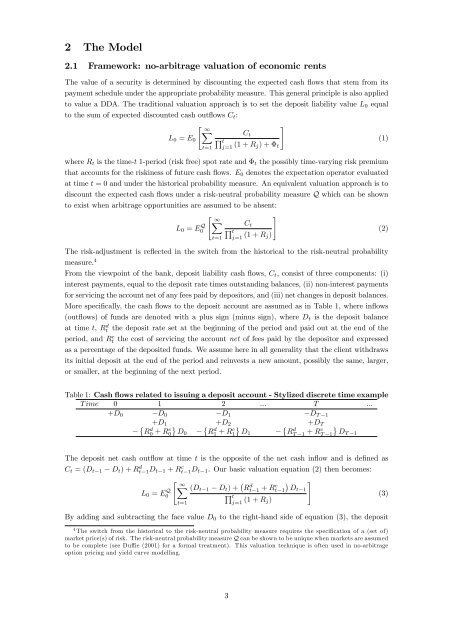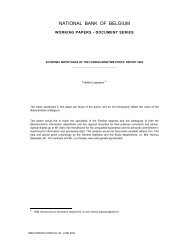A multi-factor model for the valuation and risk management of ...
A multi-factor model for the valuation and risk management of ...
A multi-factor model for the valuation and risk management of ...
You also want an ePaper? Increase the reach of your titles
YUMPU automatically turns print PDFs into web optimized ePapers that Google loves.
2 The Model<br />
2.1 Framework: no-arbitrage <strong>valuation</strong> <strong>of</strong> economic rents<br />
The value <strong>of</strong> a security is determined by discounting <strong>the</strong> expected cash ‡ows that stem from its<br />
payment schedule under <strong>the</strong> appropriate probability measure. This general principle is also applied<br />
to value a DDA. The traditional <strong>valuation</strong> approach is to set <strong>the</strong> deposit liability value L 0 equal<br />
to <strong>the</strong> sum <strong>of</strong> expected discounted cash out‡ows C t :<br />
" 1<br />
#<br />
X C t<br />
L 0 = E 0 Q t<br />
j=1 (1 + R (1)<br />
j) + t<br />
t=1<br />
where R t is <strong>the</strong> time-t 1-period (<strong>risk</strong> free) spot rate <strong>and</strong> t <strong>the</strong> possibly time-varying <strong>risk</strong> premium<br />
that accounts <strong>for</strong> <strong>the</strong> <strong>risk</strong>iness <strong>of</strong> future cash ‡ows. E 0 denotes <strong>the</strong> expectation operator evaluated<br />
at time t = 0 <strong>and</strong> under <strong>the</strong> historical probability measure. An equivalent <strong>valuation</strong> approach is to<br />
discount <strong>the</strong> expected cash ‡ows under a <strong>risk</strong>-neutral probability measure Q which can be shown<br />
to exist when arbitrage opportunities are assumed to be absent:<br />
L 0 = E Q 0<br />
" 1<br />
X<br />
t=1<br />
C t<br />
Q t<br />
j=1 (1 + R j)<br />
The <strong>risk</strong>-adjustment is re‡ected in <strong>the</strong> switch from <strong>the</strong> historical to <strong>the</strong> <strong>risk</strong>-neutral probability<br />
measure. 4<br />
From <strong>the</strong> viewpoint <strong>of</strong> <strong>the</strong> bank, deposit liability cash ‡ows, C t , consist <strong>of</strong> three components: (i)<br />
interest payments, equal to <strong>the</strong> deposit rate times outst<strong>and</strong>ing balances, (ii) non-interest payments<br />
<strong>for</strong> servicing <strong>the</strong> account net <strong>of</strong> any fees paid by depositors, <strong>and</strong> (iii) net changes in deposit balances.<br />
More speci…cally, <strong>the</strong> cash ‡ows to <strong>the</strong> deposit account are assumed as in Table 1, where in‡ows<br />
(out‡ows) <strong>of</strong> funds are denoted with a plus sign (minus sign), where D t is <strong>the</strong> deposit balance<br />
at time t, Rt<br />
d <strong>the</strong> deposit rate set at <strong>the</strong> beginning <strong>of</strong> <strong>the</strong> period <strong>and</strong> paid out at <strong>the</strong> end <strong>of</strong> <strong>the</strong><br />
period, <strong>and</strong> Rt c <strong>the</strong> cost <strong>of</strong> servicing <strong>the</strong> account net <strong>of</strong> fees paid by <strong>the</strong> depositor <strong>and</strong> expressed<br />
as a percentage <strong>of</strong> <strong>the</strong> deposited funds. We assume here in all generality that <strong>the</strong> client withdraws<br />
its initial deposit at <strong>the</strong> end <strong>of</strong> <strong>the</strong> period <strong>and</strong> reinvests a new amount, possibly <strong>the</strong> same, larger,<br />
or smaller, at <strong>the</strong> beginning <strong>of</strong> <strong>the</strong> next period.<br />
#<br />
(2)<br />
Table 1: Cash ‡ows related to issuing a deposit account - Stylized discrete time example<br />
T ime 0 1 2 ... T ...<br />
+D 0 D 0 D 1 D T 1<br />
+D 1 +D 2 +D T<br />
R<br />
d<br />
0 + R c 0 D 0<br />
<br />
R<br />
d<br />
1 + R c 1 D 1<br />
<br />
R<br />
d<br />
T 1 + R c T 1 D T 1<br />
The deposit net cash out‡ow at time t is <strong>the</strong> opposite <strong>of</strong> <strong>the</strong> net cash in‡ow <strong>and</strong> is de…ned as<br />
C t = (D t 1 D t ) + R d t 1D t 1 + R c t 1D t 1 . Our basic <strong>valuation</strong> equation (2) <strong>the</strong>n becomes:<br />
L 0 = E Q 0<br />
" 1<br />
X<br />
t=1<br />
(D t 1 D t ) + R d t 1 + R c t 1<br />
Dt 1<br />
Q t<br />
j=1 (1 + R j)<br />
By adding <strong>and</strong> subtracting <strong>the</strong> face value D 0 to <strong>the</strong> right-h<strong>and</strong> side <strong>of</strong> equation (3), <strong>the</strong> deposit<br />
4 The switch from <strong>the</strong> historical to <strong>the</strong> <strong>risk</strong>-neutral probability measure requires <strong>the</strong> speci…cation <strong>of</strong> a (set <strong>of</strong>)<br />
market price(s) <strong>of</strong> <strong>risk</strong>. The <strong>risk</strong>-neutral probability measure Q can be shown to be unique when markets are assumed<br />
to be complete (see Du¢ e (2001) <strong>for</strong> a <strong>for</strong>mal treatment). This <strong>valuation</strong> technique is <strong>of</strong>ten used in no-arbitrage<br />
option pricing <strong>and</strong> yield curve <strong>model</strong>ling.<br />
#<br />
(3)<br />
3
















